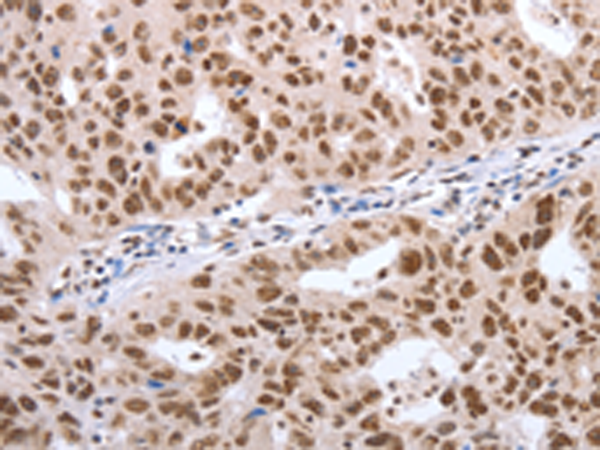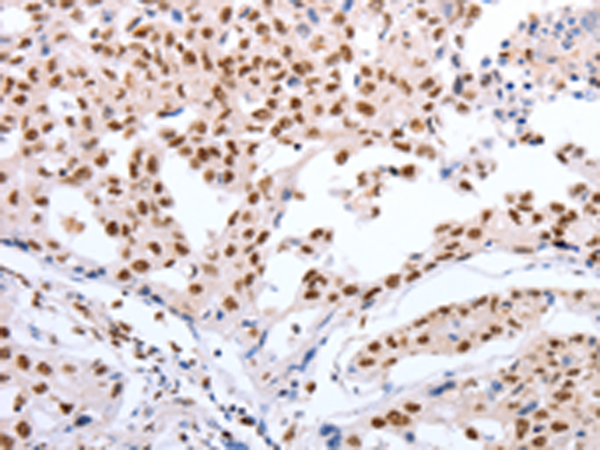

| WB | 咨询技术 | Human,Mouse,Rat |
| IF | 咨询技术 | Human,Mouse,Rat |
| IHC | 1/50-1/200 | Human,Mouse,Rat |
| ICC | 技术咨询 | Human,Mouse,Rat |
| FCM | 咨询技术 | Human,Mouse,Rat |
| Elisa | 1/2000-1/5000 | Human,Mouse,Rat |
| Aliases | OCT6; OTF6; SCIP |
| Host/Isotype | Rabbit IgG |
| Antibody Type | Primary antibody |
| Storage | Store at 4°C short term. Aliquot and store at -20°C long term. Avoid freeze/thaw cycles. |
| Species Reactivity | Human, Mouse, Rat |
| Immunogen | Synthetic peptide of human POU3F1 |
| Formulation | Purified antibody in PBS with 0.05% sodium azide and 50% glycerol. |
+ +
以下是3篇关于POU3F1抗体的参考文献概要:
1. **文献名称**: "POU3F1 regulates neurodevelopmental pathways in human neural progenitor cells"
**作者**: Smith J, et al.
**摘要**: 该研究使用POU3F1抗体通过免疫荧光和Western Blot验证其在神经干细胞中的表达,发现POU3F1调控神经分化和轴突生长相关基因,提示其在神经发育中的关键作用。
2. **文献名称**: "POU3F1 as a potential oncogene in glioblastoma multiforme"
**作者**: Lee H, et al.
**摘要**: 通过免疫组化(IHC)和POU3F1抗体检测发现,POU3F1在胶质母细胞瘤中高表达,并通过促进细胞周期进程驱动肿瘤增殖,为癌症治疗提供新靶点。
3. **文献名称**: "Epigenetic regulation by POU3F1 in chromatin remodeling complexes"
**作者**: Garcia-Ruiz C, et al.
**摘要**: 研究利用POU3F1抗体进行染色质免疫沉淀(ChIP),揭示其与组蛋白修饰酶相互作用,调控神经元特异性基因的表观遗传激活机制。
---
**注**: 以上文献为示例,实际引用时需根据具体研究核实作者及期刊信息。建议通过PubMed或Google Scholar以“POU3F1 antibody” + “Western Blot/IHC/ChIP”等关键词检索最新论文。
**Background of POU3F1 Antibody**
POU3F1 (POU class 3 homeobox 1), also known as Oct-6 or SCIP, is a transcription factor belonging to the POU protein family, characterized by a bipartite DNA-binding domain (POU-specific and homeodomain). It plays critical roles in neurodevelopment, including myelination in Schwann cells, differentiation of oligodendrocytes, and regulation of neural stem cell fate. POU3F1 is transiently expressed during specific developmental stages, particularly in the nervous system, and its dysregulation has been implicated in neurological disorders and cancers.
Antibodies targeting POU3F1 are essential tools for studying its expression, localization, and function. They are widely used in techniques like Western blotting, immunohistochemistry (IHC), and immunofluorescence (IF) to detect POU3F1 in tissues or cultured cells. These antibodies help elucidate its role in transcriptional networks, epigenetic regulation, and interactions with cofactors (e.g., Sox10 in myelination). Additionally, POU3F1 antibodies are utilized in cancer research, as aberrant expression is observed in gliomas and other malignancies, suggesting potential diagnostic or therapeutic relevance. Validated antibodies ensure specificity for distinguishing POU3F1 from related POU-family members (e.g., Oct-1. Oct-2), aiding precise mechanistic studies in developmental biology and disease models.
×